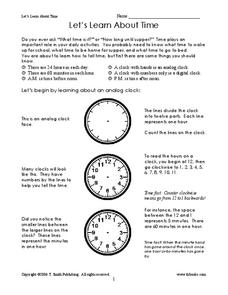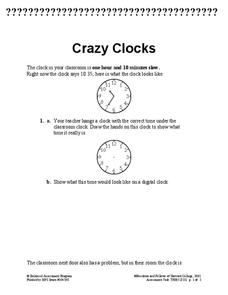Common Core Sheets
Matching Clocks (5 Minute Increments)
Second graders match the time on an analog clock to the time on a digital clock. Each sheet has 16 problems for solving.
Common Core Sheets
Creating Clocks (Half Hour Increments)
First graders create clocks by adding hour and minute hands pointing to the given time. All times are to be written in 30-minute intervals.
Common Core Sheets
Reading an Analog Clock (1 Minute Increments)
Third graders read analog clocks and tell time to the nearest minute. AM and PM do not matter in this exercise.
Common Core Sheets
Matching Clocks (Half Hour Increments)
First graders read an analog clock and then match it to the corresponding digital clock. Each clock tells time to the nearest 30 minutes.
Common Core Sheets
Reading an Analog Clock (5 Minute Increments)
Second and third graders practice reading analog clocks to the nearest five minutes.
Math Learning Center
Grade 2 Supplement Set D5 – Measurement: Telling Time
Have your class play concentration memory games using analog and digital clocks. Second graders become little experts with time telling to the minute, quarter, half, and hour. Use as a fun Friday treat as well as other...
Curated OER
What Time Is It? File Folder Game
Use a manila folder to make a clock game with these adorable time-related printables. The materials include an analog clock and a digital clock with all the related equipment, such as clock hands and numbers. Laminate or make the movable...
Scholastic
Study Jams! Tell Time
Third graders learn to read an analog clock to the minute by going through this interactive presentation. They view animated slides, try it themselves, and review vocabulary, all within the same website.
SEN Teacher
Clock Bingo
Telling time is an everyday occurrence, but with this resource, pupils can tell time and win! Print out customized bingo cards based on your learners' skill level by choosing different time intervals and number of cards per sheet. There...
Curated OER
What Time is it?
Here is a nice presentation on time; how to read analog clocks and calculating elapsed time. The graphics, and problems posed in this PowerPoint are especially good. One nice feature is that students are encouraged to work together in...
Curated OER
Let's Learn About Time
Learning to read an analog clock is not a lost art! Use these worksheets as you introduce youngsters to telling time. Because much of this packet is informational and includes a lot of text, this may be intended for older learners....
Education World
Teaching Students to Tell Time: Three Resources for Busy Teachers
Elementary schoolers develop time-telling skills, one skill at a time. They examine the connection between time on digital and analog (clock-face) clocks. An excellent lesson plan on teaching how to tell time!
Arcademics
Giraffe Pull
Take time to tell the time. Players compete in an online game of tug of war as giraffes. They determine the correct time in words for the displayed analog clock. Each correct response pulls the rope just a little farther.
International Technology Education Association
Reinventing Time
Take a trip through time. A lesson resource provides instruction on the origin of current measurements for time. The text explains the different tools humans used throughout history to measure time as well as provides examples such as...
Concord Consortium
Crazy Clocks
While a stopped clock is right twice a day, a fast or slow clock confuses people for weeks. Scholars observe a clock running slow and must correct it before observing a clock running fast and working it backward. Finally, a multi-step...
Benjamin Banneker Association
Celebrate Benjamin Banneker
Inventor, astronomer, surveyor, mathematician, clock maker. Learners celebrate the life of Benjamin Banneker by building creative analog clocks, making scale models, and solving problems related to surveying. The activities model the...
Illustrative Mathematics
Ordering Time
Practice telling time to the nearest five minutes in a digital and analog clock activity. Learners are prompted to order clock cards in increasing time order, and then write the time each clock represents.
Curated OER
Beginning Daily Activities Unit
Begin each day with a warm-up that has ELLs focusing their minds on a skill that will be taught that day. Focusing on verbs, each daily lesson reinforces study and self-management skills, helps learners become proficient in working with...
Mathed Up!
Reading Scales
After watching a video on how to read different types of scales, young mathematicians complete eight problems involving scales. From thermometers to number lines to rulers and clock, class members identify various numbers on scales.
National Security Agency
Time After Time
Save those precious minutes and hours spent planning math lessons with this mini-unit on telling time. Offering a series of engaging hands-on and collaborative learning activities, these three lessons teach children how to read analog...
Illustrative Mathematics
Making a Clock
Have a fun time teaching children to read analog clocks with this whole-group math activity. Using large sets of the numerals 1-12 and 0, 5, 10...55, the teacher creates a large clock on either the carpet or the white board, explaining...
Curated OER
Telling Time
Here's a great way for young time tellers to practice writing reading time words, then writing them out correctly. There are 15 watch faces with the time words above them. Kids write the actual time numbers, with the colon in between...
Curated OER
What's the Time? #2
Challenge your class's time-telling skills with fifteen analog clocks, all with blank faces. They write the hands in the correct places, all with times to the nearest five minutes. An easy way to extend this assignment would be a group...
Curated OER
What's the Time?
Can your second graders identify the time to the nearest five minutes? Seventeen analog and digital clocks prompt learners to write the correct time. The examples demonstrate how to use common references to time, such as ten minutes to...

























